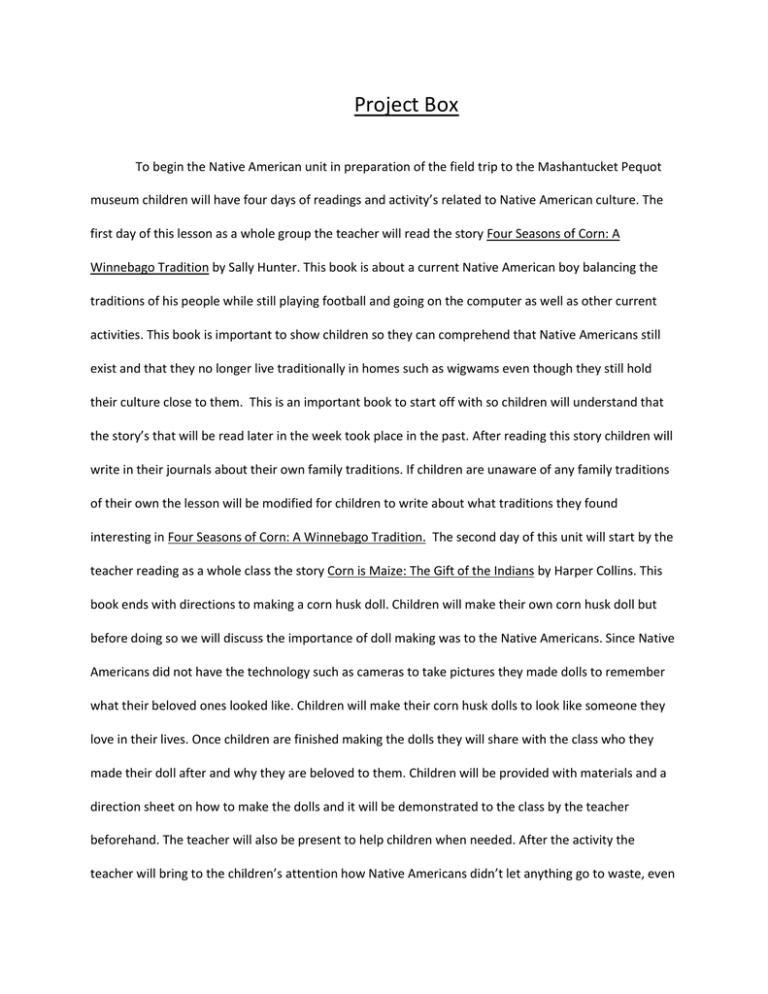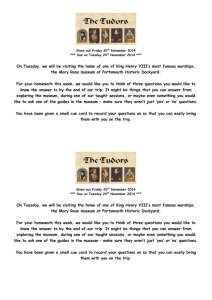Project Box - WordPress.com
advertisement

Project Box To begin the Native American unit in preparation of the field trip to the Mashantucket Pequot museum children will have four days of readings and activity’s related to Native American culture. The first day of this lesson as a whole group the teacher will read the story Four Seasons of Corn: A Winnebago Tradition by Sally Hunter. This book is about a current Native American boy balancing the traditions of his people while still playing football and going on the computer as well as other current activities. This book is important to show children so they can comprehend that Native Americans still exist and that they no longer live traditionally in homes such as wigwams even though they still hold their culture close to them. This is an important book to start off with so children will understand that the story’s that will be read later in the week took place in the past. After reading this story children will write in their journals about their own family traditions. If children are unaware of any family traditions of their own the lesson will be modified for children to write about what traditions they found interesting in Four Seasons of Corn: A Winnebago Tradition. The second day of this unit will start by the teacher reading as a whole class the story Corn is Maize: The Gift of the Indians by Harper Collins. This book ends with directions to making a corn husk doll. Children will make their own corn husk doll but before doing so we will discuss the importance of doll making was to the Native Americans. Since Native Americans did not have the technology such as cameras to take pictures they made dolls to remember what their beloved ones looked like. Children will make their corn husk dolls to look like someone they love in their lives. Once children are finished making the dolls they will share with the class who they made their doll after and why they are beloved to them. Children will be provided with materials and a direction sheet on how to make the dolls and it will be demonstrated to the class by the teacher beforehand. The teacher will also be present to help children when needed. After the activity the teacher will bring to the children’s attention how Native Americans didn’t let anything go to waste, even corn husks which we today usually throw away went to use. On the third day of this unit the teacher will read as a whole group Little White Cabin by Ferguson Plain to the class. This book demonstrates the respect Native Americans have for the elderly. In the story a boy becomes good friends with an elder and they have a lot to talk about with one another. Before this book is read arrangements will be made for children’s grandparents or other elderly friends to come into the classroom the day this book is read. Before hand as a class we will come up with topic questions we may want to ask an elder. When the elders come to the classroom they will be paired up with a child or small group of children depending on the outcome of participants and discuss with one another. Afterwards children will orally share with the class what they have learned by simply talking to an elder. The fourth day of the unit the teacher will read the book American Indian Games by Jay Miller as a whole group. After reading this story children will be taught the meaning of Native American hide and seek. It is a game that taught children how to track by looking for marks left in the ground in order to find the other hidden children. The class will then go outside and play butterfly hide and seek. Since children will be entering a museum with many artifacts present, even some available for them to touch we will read the book When Clay Sings by Byrd Baylor the day before going to the museum. This book emphasizes the importance to treat artifacts with respect explaining that every artifact was a piece of somebody’s life. After reading this story children will work with clay to make their own artifact such as a bowl. The teacher will secretly arrange a skit with another teacher in the school to further demonstrate respecting artifacts. The teacher will make their own clay artifact along with the children and once finished show all the children how proud they are of their master piece. Then the other teacher will come in pick it up and destroy it. The owner of the artifact will then act very sad and explain how that was not a nice thing to do. After the trip children will have their project box available in the classroom refresh what they have learned during their trip. The box will have a modified version of a game that was once played by the Pequot tribe for them to use at their disposal called ring and stick game. I made the game to have varying difficulty levels. There is a modified version made with a bigger ring to accommodate children who hand eye coordination may be under developed or their motor skills. For those children who need to be challenged they have the option to add on extra rings to the game making it more difficult to get them all on the stick. It is important for the Pequot tribe to be incorporated into the project box since they are a tribe that originated from the same area that the children are from. It will better help them make connections to Native Americans. The museum has many sections about Pequot’s plant food resources. In the project box there will be a matching game with descriptions of the uses of plants and then the name and picture of each plant. Children will have to pair the correct description to each plant. The project box will also have worksheets in it which was given by the museum itself. Mashantucket Pequot Museum and Research Center. 110 Pequot Trail P.O. Box 3180 Mashantucket, CT 06338-3180 http://www.pequotmuseum.org/Home/GeneralInformation/ Contact person: Dr. Kevin A. McBride Museum number: 1-800-411-9671 $8.00 a child. $11.00 an adult. This trip aligns with the social studies standards 2.2: “Interpret information from a variety of primary and secondary sources, including electronic media (e.g. maps, charts, graphs, images, artifacts,recordings and text).” The museum provides all of these resources to the children in an hands on manner. and 1.5 “Interaction between humans and the environment.” This standard will be focused around food and how Native Americans used all of their resources to their fullest. This trip also aligns with the common core state standards CC.1.SL.3“Ask and answer questions about what a speaker says in order to gather additional information or clarify something that is not understood.” and CC.1.SL.1 “Participate in collaborative conversations with diverse partners about grade 1 topics and texts with peers and adults in small and larger groups.” This trip aligns with a first grade curriculum to better develop students cultural awareness. It provides children with a better understanding of a Native American unit by allowing children to clearly visual the Mashantucket Pequot culture. Before the trip children’s curriculum will include Mashantucket Pequot’s family dynamics, homes, food and the influence that Europeans had on the Native Americans. This field trip will allow children to further their understanding of the subject matter. It meets the curriculum of teaching students the historic past of their own state. Children will master skills and knowledge that they can apply in the context of family dynamics and a variety of worldwide cultures. This activity will encourage acceptance of different cultures and lead to critical thinking. This museum is known for the interactive experience of Native American culture from the U.S and Canada. There are changing events and exhibits every year, such as a monthly beading circle. The scheduling for the trip can be made Wednesday through Saturday, 9 am–5 pm by calling group sales coordinator at (860) 396-6839. This museum strives for full accessibility for all with a multi-sensory design throughout the building. Ramps and elevators are present throughout the museum and all hands on activities are designed for easy wheel chair access height. Talking signs are present so the visual impaired can be self-dependent while walking through the museum. In various areas of the museum braille is also present. Signs are also in large print for those who are visually impaired. This site provides accommodations for the hearing impaired as well such as captions on videos and infrared assistive listening devices for the auditorium. One chaperone will be needed for every five students who attend the trip. The trip will take all day. Students may bring a lunch or purchase one at the site. Before attending the trip students should have a basic understanding of Native American culture, specifically focusing on the Pequot tribe. While at the museum students will be asked to look for any new or reinforcing facts about Native American culture regarding housing, family dynamics, food and the interactions they had with Europeans. Students will be transported by a school bus. Arrangements will need to be made with the bus company to bring children and pick them up. Project Box Materials Stick and ring game (wooden sticks, wodden circles, wooden rings, string.) Matching game (Velcro, pictures, descriptions, lamination paper.) Worksheets References “Ducksters: Fun kid site with safe search, sports, games, jokes and, and homework help.” Ducksters Technological Solutions, Inc. (TSI), Apr. 2013. Web. 1 Apr. 2013. Retrieved 4/1/2013. Retrieved from: http://www.ducksters.com/ Mashantucket Pequot Museum and Research Center. Retrieved 4/1/2013. Retrieved from: http://www.pequotmuseum.org/





